Discovering Woodland Residences in Dubai's Real Estate


Intro
Dubai, a city known for its stunning skyscrapers and vibrant lifestyle, is gradually embracing a different narrative: one that intertwines nature with modern living. The concept of woodland residences is taking root, providing an appealing alternative for homebuyers and investors seeking a slice of green in the bustling desert metropolis. As we venture into this guide, expect to uncover the essence of living amidst trees and tranquility—delving into the architectural marvels that reflect a harmonious relationship with nature, the investment potential within these unique niches, and insights that will steer your decisions in the evolving real estate landscape of Dubai.
Market Analysis
Current Trends in Dubai Real Estate
The real estate scene in Dubai is in constant flux, adapting to the changing needs of its cosmopolitan residents. Among the trends emerging is a noticeable shift towards eco-friendly designs that prioritize sustainability. Woodland residences, offering verdant surroundings and greener living options, are increasingly sought after by expatriates who wish to escape the urban commotion while still enjoying proximity to city amenities.
In the context of this evolution, developers are showcasing innovative designs, frequently incorporating natural materials and sustainable building practices. The trend isn't merely aesthetic but also appeals to those armed with the understanding of environmental stewardship.
Price Dynamics and Forecasts
Understanding the pricing in the woodland segment is crucial for potential buyers. While prices can vary based on location, proximity to city hubs, and the specific amenities offered, many woodland residences operate within a competitive range that presents fair value considering their unique offerings.
Experts predict a gradual increase, influenced by rising demand and limited supply of these nature-centric homes. Buyers today aren’t just investing in property; they are purchasing a lifestyle— and the forecast shows an upward trend for those willing to embrace nature-infused living.
Investment Opportunities
Insights on High-Return Investments
Investing in woodland residences not only fosters a connection to nature but can also yield significant financial returns. These properties are becoming increasingly appealing, particularly to expatriates and investors looking for long-term value. The allure lies in their potential for capital appreciation as urban sprawl encourages the development of more green zones.
Moreover, eco-friendly properties tend to attract tenants who are willing to pay a premium for sustainable living options. This demand can ensure a steady and sound rental income, making woodland residences a smart choice for investors eager to diversify their portfolios.
Emerging Neighborhoods for Expatriates
Several neighborhoods within Dubai are particularly catching the attention of expatriates looking for woodland residences. Places like the Dubai Hills Estate and Arabella in Mudon are notable examples, where the developers have aligned their projects with the emphasis on green living.
These communities not only offer scenic beauty but also promise a lively environment, complete with sports facilities, walking trails, and community parks—perfect for families and nature enthusiasts alike.
Homebuyers considering these areas should act promptly, for the combination of natural vistas and modern living guarantees that they are hot spots ripe for investment.
"Investing in a woodland residence today means planting the seeds for flourishing returns tomorrow."
As we delve into the unique characteristics that define woodland living in Dubai, let’s explore how this concept is being realized through sustainable designs and community-oriented spaces.
Prelude to Woodland Residences
In the context of Dubai's expanding real estate market, woodland residences represent an intriguing development that melds luxury living with the tranquility of nature. The potential for homeowners and investors alike in this niche sector is considerable, as it not only offers stunning views and an immersive natural environment but also aligns with growing demands for sustainability in modern living. The serene atmosphere of these residences promotes a lifestyle that is rich in experience, away from the hustle and bustle of city life. Within this article, we will delve into the many facets of woodland living, emphasizing its appeal and practical considerations.
Defining Woodland Residences
Woodland residences are characterized by their integration into forested or semi-forested areas, distinctly focused on harmony with nature. These homes often feature eco-friendly designs that utilize materials sourced from the surrounding environment. In many cases, residences blend indoor and outdoor spaces, maximizing natural light and views of greenery. They prioritize landscape design that enhances both aesthetic appeal and biodiversity, fostering a deeper connection between inhabitants and their surroundings.
This type of living not only caters to those seeking peaceful retreats but also aligns with a more conscious lifestyle choice, appealing to a market that increasingly values sustainability.
Historical Context of Woodland Living
The concept of woodland living is not entirely new and can be traced back to various cultures that have historically sought refuge in nature. For instance, Scandinavian settlers designed their homes to coexist with the woodlands, establishing a tradition of architectural styles that remain relevant today. The modern interpretation in places like Dubai combines these ancient principles with cutting-edge technology and contemporary design.
While Dubai may be primarily known for its urban skyline and rapid development, the emergence of woodland residences offers an interesting juxtaposition—showcasing that nature-integrated living can thrive even within an urban fabric. Today’s residents are increasingly looking to the past as they choose to invest in woodland homes, prioritizing a balanced lifestyle that promotes well-being and community cohesion.
Architectural Styles in Woodland Residences
Architectural styles play a critical role in defining the essence of woodland residences. These designs not only enhance the aesthetic appeal of homes nestled in greenery, but also promote sustainability and harmony with the surrounding environment. As more people seek a blend of modern living and natural beauty, the architectural choices in woodland residences evolve to reflect this desire. Homebuyers and investors alike find themselves drawn to these innovative approaches that prioritize ecological considerations.
Sustainable Design Principles
Sustainable design principles are at the heart of woodland architecture. Integrating buildings with the landscape is not merely an aspiration but a necessity in today's world. Key elements of sustainable design include:
- Maximizing Natural Light: Homes are often oriented to capture sunlight, reducing the need for artificial lighting and decreasing energy costs.
- Energy Efficiency: Utilizing passive solar design and energy-efficient appliances ensures a lower carbon footprint.
- Use of Eco-Friendly Materials: Many woodland residences employ materials like reclaimed wood and bamboo, which have a minimal environmental impact.
- Water Management Systems: Rainwater harvesting systems and greywater recycling contribute significantly to sustainable living.
These principles not only address immediate ecological concerns but also assure potential buyers that their investment aligns with future sustainability goals.
Contemporary Trends in Architecture
As we move further into the 21st century, woodland residences reflect contemporary architectural trends that resonate with urban dwellers yearning for nature. Trending designs often showcase:
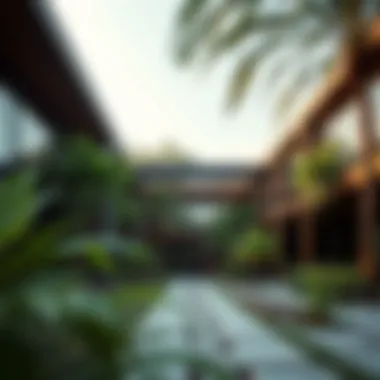
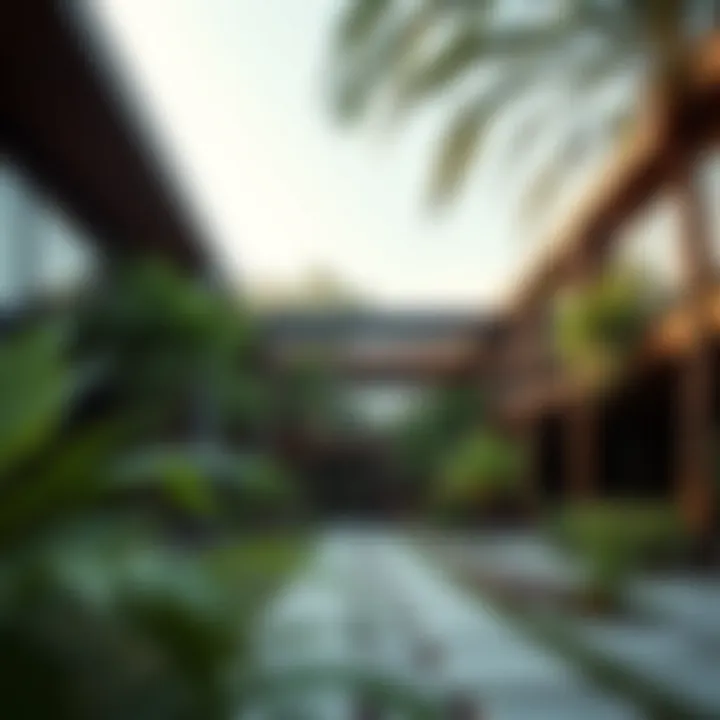
- Open Floor Plans: Promoting a seamless indoor-outdoor flow, this style caters to the modern family’s lifestyle while enhancing accessibility to nature.
- Biophilic Design: Incorporating elements of nature within the home—like green walls, indoor gardens, and large windows—encourages a connection with the surrounding environment.
- Minimalist Aesthetics: Stripped-down designs focus on functionality and simplicity, appealing to those who wish for less clutter and an appreciation for quality over quantity.
Each of these trends contributes to creating spaces that are not only visually stunning but also practical for daily living, appealing especially to families and young professionals.
Materials and Construction Techniques
The materials selected for woodland residences significantly influence both their appearance and functionality. Commonly used materials include:
- Sustainable Timber: Sourced from responsibly managed forests, timber adds warmth to residences while maintaining structural integrity.
- Natural Stone: Known for its durability and timeless appeal, stone ties homes visually to the environment.
- Green Insulation: Products made from sheep's wool, straw, or recycled paper ensure superior insulation without harmful chemicals.
Additionally, construction techniques are evolving to embrace advanced technology. Prefabrication, for example, reduces waste and enhances efficiency. Homebuilders are increasingly turning to modular designs that allow for quicker assembly while minimizing environmental impact.
The synthesis of sustainable materials and advanced construction methods fosters a sense of stewardship towards the environment, making woodland living not only desirable but essential in today's evolving landscape.
Benefits of Woodland Living
Woodland residences are not just homes; they represent a lifestyle deeply intertwined with nature. People are increasingly drawn to these serene spaces for their numerous benefits. In a bustling city like Dubai, where concrete towers dominate the skyline, the allure of greenery and natural surroundings is hard to resist. The living experience in these woodland communities is not merely about aesthetics but encompasses significant advantages related to mental well-being, social engagement, and a stronger connection to the environment.
Connection to Nature
Living in a woodland area offers an unparalleled connection to nature. Imagine stepping out of your front door and being greeted by the rustling leaves and chirping birds. This daily interaction with nature isn’t something to take lightly. Studies have shown that exposure to natural surroundings can significantly reduce stress levels and promote mental clarity. It’s like taking a deep breath of fresh air — revitalizing and wholesome. Moreover, many woodland residences prioritize sustainable living practices, such as using solar energy and rainwater harvesting systems, enhancing this bond with the environment. Residents often find themselves engaging in outdoor activities like hiking, bird watching, or simply enjoying a cup of coffee while taking in the sights and sounds of nature. This creates a lifestyle that is conducive to relaxation and reflection.
Community and Lifestyle Benefits
Woodland communities in Dubai often feature a blend of cultural diversity and social interaction. People moving into these serene neighborhoods typically seek camaraderie, forging bonds with neighbors through shared interests in sustainability and nature. Community gardens or cooperative landscaping projects are common, where residents might gather to plant new trees or grow herbs and vegetables.
This sense of community often transcends mere location. Residents share not only their living space but also experiences, celebrations, and even challenges. Regular events, such as outdoor movies or potluck gatherings, foster interaction among residents. Additionally, having access to like-minded individuals enhances the overall quality of life, providing support systems that make living in a new area easier for expatriates and locals alike.
Health and Wellness Advantages
The health benefits of living in woodland residences are manifold. Regular physical activities, such as gardening or hiking, encourage a more active lifestyle, improving cardiovascular health and promoting physical fitness. The tranquility and clean air associated with such areas can lead to improved respiratory health, while the mental health benefits are profound as well. Engaging with nature has been linked to lowered rates of anxiety and depression.
"Living amidst nature can act as a natural antidote to the fast-paced urban lifestyle, allowing individuals to reset and recharge."
Moreover, many studies indicate that views of greenery can enhance cognitive functions and improve mood. Parents often find that their children are more active and healthier when raised in these environments, learning to appreciate and nurture the world around them.
Challenges of Woodland Residences
Navigating the intricacies of woodland living isn't all sunshine and butterflies. It comes with its own set of hurdles that anyone considering a move to these natural havens should be well aware of. Understanding these challenges provides homeowners and investors with a realistic view, ensuring they are better prepared for any bumps along the road.
Environmental Considerations
One cannot speak of woodland living without touching upon the environmental impacts tied to such residences. First and foremost, building in forested areas can disrupt local ecosystems. While sustainable practices are gaining traction, there's an increasing tension between development and nature conservation. Specific flora and fauna might be endangered due to construction activities, prompting the need for environmental assessments before any building takes place.
Moreover, it's essential to consider water management and soil erosion. In heavy rains, wooded areas can suffer more from runoff, which can lead to flooding or degraded land quality. Placing too many amenities can alter the landscape's natural courses, potentially causing long-term damage. Logically, maintaining biodiversity should remain paramount, as this influences not just beauty, but the overall health of the environment.
Maintenance and Upkeep
On the flip side, once the dust settles and you've moved into your woodland home, maintenance becomes your new best friend—or your worst enemy, depending on your perspective. Nature doesn't always play nice, and living in a forest comes with peculiar upkeep challenges. From fallen branches in stormy weather to the occasional visit from wildlife, homeowners must be ready for the unexpected.
Regular cleaning and maintenance of pathways, roofs, and gutters are crucial, especially as leaves fall and collect. Ignoring these maintenance tasks could lead to more significant issues down the line, like blocked drainage systems or, worse, mold forming in damp spots.
Also, consider the ongoing costs of maintaining natural landscapes. While lush greenery looks appealing, it can require specific care that doesn't come cheap. You might invest in landscaping services that sustainably manage flora and fauna on your property, which, while helpful, can bite into your budget.
In short, it’s clear that the journey of woodland living is not without its trials. Yet, for those who cherish the serenity of nature, these challenges can often be overcome with foresight and proper planning, leading to a rewarding living experience amidst the trees.
Investment Potential in Woodland Properties
Given the unique blend of natural beauty and urban convenience, investing in woodland properties in Dubai presents a compelling opportunity for various stakeholders. This section dives into the economic landscape of woodland residences and outlines key considerations for potential investors beyond just aesthetics.
Market Trends in Dubai's Woodland Sector
Dubai's real estate market, known for its rapid transformation, has begun to place a greater emphasis on sustainability and nature-oriented living. Over the past several years, there has been a noticeable shift towards eco-friendly housing options. Investors are not just looking at square footage or luxury amenities anymore; they are looking for properties that foster a connection with nature.
- Increased Demand: Homebuyers are increasingly valuing green spaces, leading to a surge in demand for woodland residences.
- Sustainability Initiatives: The UAE government has launched several initiatives to promote sustainable living, enhancing the appeal of these properties.
- High Return on Investment: Areas like Dubai Hills and Arabian Ranches are witnessing increased property values due to their proximity to green zones. The investment potential is often bolstered by ongoing infrastructural improvements as well.
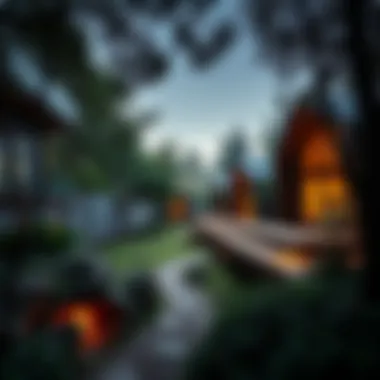
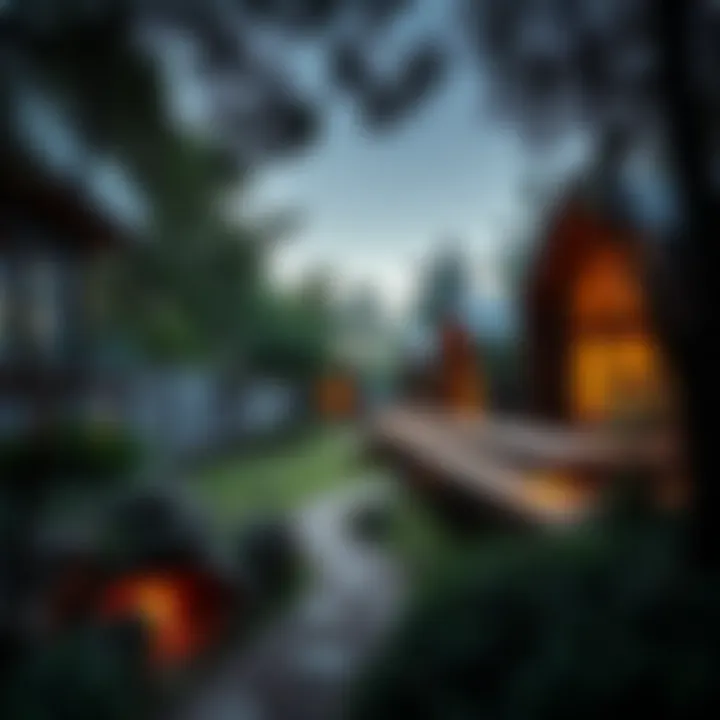
The woodland sector is becoming increasingly viable due to these trends, which suggest a robust future market.
Forecasting Property Values
In the realm of woodland properties, forecasting can be somewhat less straightforward than in more urbanized sectors. Several factors contribute to property value in these areas:
- Location: Proximity to urban centers without sacrificing the tranquility that comes with woodland settings plays a significant role. Homes nestled in serene environments but within a short drive of city amenities command higher prices.
- Unique Selling Points (USP): Features such as eco-friendly design, smart home technology, and access to recreational spaces influence a property's market value. Homes with these elements are often more sought after.
- Economic Shifts: Broader economic conditions, including interest rates and employment levels, directly impact property transactions and values. Keeping a pulse on economic indicators is essential for predicting future values accurately.
In this regard, historical growth rates of similar properties can serve as a guideline for potential appreciation. Expatriate interests also increase demand, further influencing property market dynamics.
Navigating the Investment Process
Investing in woodland properties in Dubai requires a nuanced understanding of the local market. Potential buyers should consider these elements when initiating the purchase process:
- Research: It's vital to conduct thorough research on specific neighborhoods, examining factors like community feedback, development plans, and environmental regulations.
- Legal Framework: Familiarity with local laws concerning property ownership, especially for expatriates, is crucial. Regulations can vary widely depending on property type and location.
- Engage Professionals: Working with experienced real estate agents familiar with the woodland sector can provide invaluable insights and streamline the purchasing process.
- Financing Options: Investigating financing options that suit the investment type enhances flexibility. Many banks are beginning to offer tailored mortgage solutions for eco-friendly homes, making it easier for buyers to secure funding.
Overall, navigating the investment process in woodland residences is less about following trends and more about establishing a strong strategy that integrates personal lifestyle choices with sound financial practices. Successful investments often align seamlessly with broader market movements, ensuring growth potential.
The investment in woodland properties is not merely transactional; it embodies a lifestyle choice that resonates with those looking for a harmonious blend of nature and modern living.
Expatriate Experiences in Woodland Communities
Living in woodland residences in Dubai presents a unique and enriching experience for expatriates. These communities offer a retreat from the bustling urban life, fostering a sense of connection not just to nature, but also to each other. The tranquil settings, complemented by lush greenery and open spaces, cultivate an environment conducive to community living, where expatriates can weave their own fabric of social networks.
Cultural Integration and Social Life
For expats, cultural integration is often the first hurdle. Woodland communities tend to be melting pots of diverse backgrounds and traditions. It’s a bit like tossing a salad—each ingredient adds its unique flavor, and together they create a tasty dish. Many woodland neighborhoods organize community events, such as potlucks and cultural evenings, providing an opportunity for residents to showcase their culinary skills and cultural traditions.
Sharing a meal or celebrating a festival with neighbors can break down barriers and encourage friendships. Such interactions create a sense of belonging and make the expat experience more fulfilling. Also, local clubs, ranging from book clubs to sports leagues, allow residents to meet like-minded individuals, further solidifying their social ties.
Being part of a community that shares a passion for nature also paves the way for more experiential social activities. Nature walks, gardening workshops, or even outdoor yoga sessions become avenues for forming connections. This communal passion for greenery stimulates discussion and shared experiences, heightening the overall sense of unity.
Challenges Faced by Expatriates
Despite the warm embrace of community life, expats often encounter their own set of challenges in these woodland enclaves. One significant hurdle is the sense of isolation that can surface, especially for those new to the area. While the trees stand tall and comforting, they can sometimes feel like they’re closing in, creating a sense of seclusion. This can be particularly daunting for individuals who are accustomed to a bustling city environment.
Communication barriers may contribute to this sense of disconnect. Not all expatriates may be familiar with the local language or cultural norms, making it challenging to forge connections. Furthermore, newcomers might find it hard to join established social circles, which can lead to feelings of being an outsider.
Additionally, the pace of life in woodland areas can be different than what many expatriates might expect. For those rushing to keep up with fast-paced city life, adapting to a more relaxed routine can take time and patience.
In terms of practical challenges, expats may face difficulties related to residence permits, property law, and the intricacies of navigating local regulations. Understanding the official procedures can sometimes feel like deciphering a complex puzzle, a source of frustration for new arrivals.
Conclusively, while woodland residences offer expatriates a greener lifestyle infused with community spirit, it is essential for them to remain aware of and prepared for the nuances of adapting to these vibrant environments. The journey may present obstacles, but with an open mind and a heart ready to embrace new experiences, the rewards of woodland living are plentiful.
"Living amidst nature is not just a choice; it's an adventure waiting to unfold every day."
For more information about integrating into Dubai as an expatriate, resources can be found on expat-focused platforms such as Expatica and community forums on Reddit where personal experiences and advice flow freely.
Legal Considerations in Woodland Property Transactions
Understanding the legal landscape of woodland property transactions is crucial for anyone looking to invest in this unique segment of the Dubai real estate market. The rules and regulations specific to properties nestled within wooded areas can differ substantially from those applicable to more traditional residential properties. Knowing these intricacies not only helps in making informed decisions but also safeguards against potential pitfalls that could arise during the buying or leasing processes.
Understanding Local Property Laws
Diving into Dubai's property laws, it is vital to grasp that local legislation considers diverse factors such as land use, ownership rights, and zoning regulations. In recent years, Dubai has attempted to streamline its property laws to attract a wider array of investors. However, woodland properties often come with additional layers of regulation designed to protect the natural environment.
For instance, the Dubai Land Department oversees land transactions and ensures compliance with environmental laws that govern how these properties can be developed and maintained. It's essential for potential homeowners to consult the regulations concerning any proposed alterations to the natural landscape, as unauthorized modifications can lead to hefty fines or even legal action.
Moreover, this area often requires adherence to sustainability standards that dictate how structures should coexist with their surroundings. Such standards emphasize eco-friendliness, making it imperative for buyers to familiarize themselves with guidelines set by government agencies like the Dubai Environment Agency.
Documentation and Permits Required
Navigating the paperwork trails to purchase woodland property might feel like a maze, but understanding required documents can smooth the path. When buying in woodland zones, prospective buyers should come prepared with several essential documents:
- Title Deed: This serves as proof of ownership and is critical in establishing rights.
- No Objection Certificate (NOC): This document from local authorities is often necessary, particularly if the property is located in regulated areas.
- Environmental Assessment Report: Depending on the scale and impact of any proposed development, this report is crucial for addressing potential ecological concerns.
- Sale and Purchase Agreement (SPA): A legally binding document that outlines the terms of the sale, ensuring both parties are on the same page.
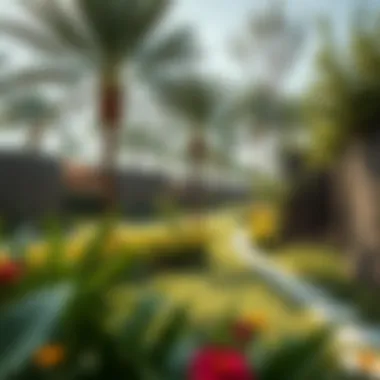

In many instances, securing these documents also entails going through various channels, which can be time-consuming. Engaging with local estate agents who specialize in woodland properties can considerably ease the complication of these legal obligations. They not only help with paperwork but also offer insights into navigating the nuances of local regulations.
"Acquainting yourself with legal obligations before diving into property matters can save a world of trouble down the line."
Community Features of Woodland Residences
The significance of community features in woodland residences cannot be overstated, especially in a bustling city like Dubai. Communities that nurture a connection to nature, paired with modern conveniences, create a unique lifestyle that appeals to many homebuyers and investors alike. Woodland locations thrive on the balance of natural beauty and community infrastructure, giving residents a reason to cherish their surroundings while enjoying a satisfying standard of living.
Parks and Recreational Areas
Parks and recreational areas serve as the heart of any woodland community. These spaces are vital for fostering connections among residents and establishing a sense of belonging. Imagine stepping out of your front door to a verdant park filled with trees, paths, and possibly a serene pond. Parks often host family-friendly events like movie nights, fitness classes, or seasonal festivals, which promotes social interaction.
Moreover, their design prioritizes both play and relaxation. Children's playgrounds with soft surfaces encourage little ones to explore, while adults may enjoy walking trails or picnic spots. The integration of diverse flora and fauna not only beautifies these areas but also enriches the local ecosystem.
In a fast-paced city where old brick and modern steel reign, these green spaces provide a much-needed balance, offering both tranquility and adventure. Social activities encourage an active lifestyle, where people jog or cycle together. Fun fact: research indicates that access to parks can lead to improved mental health and enhanced community engagement.
Access to Amenities and Services
Another key aspect of woodland residences is the accessibility of amenities and services. Having vital services nearby is crucial — it makes everyday life more manageable and simultaneously supports the community's ecosystem.
Residents of these areas can enjoy a blend of nature and convenience. For instance, grocery stores, health clinics, and schools are often within a short drive or even walking distance. This arrangement promotes a sustainable lifestyle, as people are less reliant on cars and more inclined to walk or take public transport, decreasing traffic congestion and benefiting the environment.
Aside from basic services, many woodland communities develop additional amenities like cafes, boutiques, or artisan shops. This creates opportunities for local entrepreneurs and enhances the overall aesthetic appeal of the area. The idea is to foster a vibrant local economy where residents not only live but thrive.
Ultimately, the combination of parks, recreational areas, and access to essential services fortifies the community feel of woodland residences, allowing for a lifestyle that integrates both nature and modernity. As homebuyers and investors pursue options in Dubai, understanding these community features can inform their choices immensely.
"In the dance between urban living and nature-inspired communities, knowing what features to prioritize can make all the difference in the quality of life you experience."
For more information about Dubai's woodland area communities and their community features, consider visiting Wikipedia for insights on urban green spaces or Britannica for a broader understanding of community living.
Future Developments in Woodland Residences
The future of woodland residences in Dubai is a landscape influenced by ambition, innovation, and a deeper appreciation for nature. As urban living encroaches on these serene pockets, the need for developments that prioritize both residential comfort and environmental integrity has never been more crucial. This section highlights the essence of future constructions in woodland areas, looking closely at the innovative housing projects underway and their impact on the environment and economy.
Innovative Housing Projects
As urban planners and developers grapple with the pressures of modern life, they increasingly turn towards designs that blend seamlessly with nature. This has led to a new wave of innovative housing projects that prioritize sustainability while offering comfortable living.
Some standout examples include:
- Eco-Friendly Villas: Architecturally striking yet environmentally considerate, these residences incorporate renewable energy sources, such as solar panels, and utilize sustainable materials sourced locally. This minimizes the carbon footprint from the outset.
- Vertical Gardens: Adapting urban residential units to feature vertical gardens allows for lush greenery to be part of daily living, thus promoting biodiversity while enhancing air quality. This approach reflects a commitment to marrying architecture with nature.
- Smart Home Technology: New builds are increasingly integrating smart home solutions to improve energy efficiency. Homeowners can control energy consumption remotely, configure security systems, or even manage their indoor climate for ultimate comfort.
Developers are also keen on fostering communal spaces in these housing projects. The emphasis is on creating environments that encourage community engagement and a shared lifestyle, further enhancing the appeal of woodland living. One great concept involves building shared gardens and parks, promoting interaction among residents and a sense of belonging.
Impact on the Environment and Economy
The investment in woodland residences doesn’t just cater to the housing market; it ripples through broader economic and environmental domains, nurturing both.
"Sustainable developments not only benefit the homeowners but also contribute positively to the ecosystem.”
From an environmental standpoint:
- Biodiversity Preservation: Planned developments can help restore local flora and fauna, aiding conservation efforts in urban settings. Residential spaces designed with green corridors allow for safe wildlife passage.
- Water Management: Advanced rainwater harvesting systems are integrated into many of these projects, ensuring that water resources are used wisely. Techniques such as permeable paving also reduce stormwater runoff, contributing to sustainable groundwater replenishment.
On the economic front:
- Property Value Appreciation: As more individuals seek eco-friendly living options, the demand for woodland residences is set to rise. Properties in these areas are likely to see an increase in value, making them attractive for investors.
- Job Creation: As these innovative projects unfold, so do opportunities for local employment, from construction roles to ongoing maintenance services related to sustainability initiatives.
The future of woodland residences in Dubai appears not just promising but is marked by a conscious effort to align modern living with the natural environment. Understanding these forthcoming developments is paramount for potential homebuyers and investors seeking to make informed decision in a rapidly evolving market.
The End: The Appeal of Woodland Living in Dubai
In the ever-changing landscape of Dubai’s real estate market, woodland residencies emerge as a compelling choice for those seeking a harmonious blend of nature and urban living. The relevance of this topic lies in its timely exploration of unique lifestyles in a city that is often seen as a concrete jungle. For homebuyers, investors, and individuals looking to bask in the tranquility of wooded retreats, understanding the allure of these residences can be a game changer.
Woodland living encapsulates more than just a physical space; it embodies an ethos focused on sustainability, comfort, and community. With the hustle and bustle of city life weighing heavy on many, the pull towards nature-centric living is almost magnetic. Residents find solace and rejuvenation in the lush landscapes, which are often complemented by eco-friendly designs that favor both aesthetic and environmental considerations.
Summation of Woodland Residence Benefits
The advantages of residing in woodland areas extend far beyond simple aesthetics; they echo through the lifestyle choices and health benefits associated with such environments.
- Natural Connectivity: Being surrounded by greenery does wonders for mental wellness. Scientific studies continually confirm that time spent in nature reduces stress and enhances mood. For families, this translates to outdoor playgrounds and exploration opportunities right outside their doorstep.
- Community Living: Woodland estates often foster a sense of belonging and camaraderie among neighbors. Shared spaces encourage social interactions, weaving a tight-knit fabric of community that can sometimes feel lost in more urban settings.
- Health and Wellness: The health benefits are numerous. A brisk walk or jog on a forested trail is always more invigorating than a stroll along busy sidewalks. Additionally, exposure to nature is linked to increased physical activity, which can lead to improved overall health.
In the context of Dubai, where rapid development often overtakes green initiatives, woodland residences stand as a refreshing counterpoint. They assure prospective homeowners and investors that one does not have to sacrifice a love for nature for modern conveniences. As the city advances toward sustainability, woodland living represents a promising avenue that harmonizes lifestyle with eco-ethics.
"In the world where urban sprawl often dominates, woodland residences offer a sanctuary to those who wish to reconnect with nature, providing countless benefits for both the individual and community."
For further insights into sustainable living and green spaces, consider visiting resources like Wikipedia and Britannica. For community experiences, platforms such as Reddit can provide first-hand accounts from current residents.



